|
|
 |
|
Calanoida ( Ordre ) |
|
|
|
Clausocalanoidea ( Superfamille ) |
|
|
| |
| | | |
| Aetideidae Giesbrecht, 1892 ( Clausocalanoidea ) | | Syn.: | Aëtidiina Giesbrecht,1892 (p.52); Aetidiinae : Esterly, 1905 (p.143) | | Ref.: | Sars, 1901 a (1903) (p.23); With, 1915 (p.72); Gurney, 1931 a (p.84); Rose, 1933 a (p.88); Brodsky, 1950 (1967) (p.82, 141); Vervoort, 1952 (n°41, p.2, Genera Key); Mazza, 1967 (p.106); 1968 (p.531); Bradford, 1969 b (p.473, 502: Table 3): Björnberg, 1972 (p.25); Andronov, 1974 a (p.1005); Campaner, 1978 (p.865); Bradford & Jillett, 1980 (p.11); Vaupel-Klein, 1982 a (p.1); Bowman & Abele, 1982 (p.9); Razouls, 1982 (p.153); 1993 (p.309); Brodsky & al., 1983 (p.144, 145, 147); Zheng Zhong & al., 1984 (1989) (p.235, genera Key); Mauchline, 1988 (p.426, 731, 740: cuticular pores); Huys & Boxshall, 1991 (p.460); Markhaseva, 1993 (p.51, phylogeny); Vyshkvartzeva, 1994 (p.118 & suiv.); Markhaseva, 1996 (p.3, Genera Key, Rem.: p.8); Madhupratap & al., 1996 (p.863, Table 5: %/copepods); Chihara & Murano, 1997 (p.681, Genera Key); Bradford-Grieve & al., 1999 (p.879, 903, 904, 917: Genera & spp. Key); Ohtsuka & Huys, 2001 (p.445, 461); Markhaseva & Schnack-Schiel, 2003 (p.116 & suiv., Rem.); Boxshall & Halsey, 2004 (p.12, 15, 16; 49; p. 54: Def.; p.57: Genera Key); Vives & Shmeleva, 2007 (p.533, part. Genera Key); Markhaseva & Schulz, 2008 (p.48, Fig.12: geographical distribution of benthopelagic genera); Blanco-Bercial & al., 2011 (p.103, Table 1, Fig.2, 3, 4, molecular biology, phylogeny); Laakmann & al., 2012 (p.535, Rem.: p.543, phylogeny); Markhaseva & Renz, 2015 (p.1041, Rem.: differences between Clausocalanidae and Aetideidae); Laakmann & al., 2019 (p.330, fig.1, 2, 3, Table A, phylogenetic relationships); Hirai & al., 2020 (p.1, Fig.4: metabarcoding, Fig.8: OTUs distribution patterns, Fig.9: phylogenetic analysis)
Bradford-Grieve J.M., (2002 onwards). Key to calanoid copepod families. Version 1 : 2 oct 2002. http://www.crustacea.net/crustace/calanoida/index.htm  | | Rem.: | 30 G.: Aetideopsis, Aetideus, Azygokeras, Batheuchaeta, Bradyetes, Bradyidius, Chiridiella, Chiridius, Chirundina, Chirundinella, Comantenna, Crassantenna, Euchirella, Gaetanus, Gaidiopsis, ['Gaidius'= Gaetanus], Jaschnovia, Lutamator, Mesocomantenna, Paivella, Parabradyidius, Paracomantenna, Prolutamator, Pseudeuchaeta, Pseudochirella, Pseudotharybis, Pterochirella, Sursamucro, Undeuchaeta, Valdiviella.
Senecella constitue le seul genre dulçaquicole et saumâtre.
Pour Markhaseva (1996, p.8) cette famille ne comprendrait que 26 genres (avec le nouveau genre Parabradyidius); Gaidius est synonyme de Gaetanus; Wilsonidius est considéré comme un synonyme de Chirundina; Gaidiopsis est insuffisamment décrit et l'espèce type perdue; Pseudotharybis est intermédiaire entre cette famille et les Tharybidae; Valdiviella pourrait constituer le type d'une famille nouvelle.
After madhupratap & al. (1996), la famille des Aetideidae représente de 0,1 à 5 % des copepodes dans la couche de mélange des eaux océaniques de la région ouest de l'Inde (Mer Arabe) en usant un filet type Multiple Plankton Closing Net à 200 µm de vide de maille (mesh aperture). | 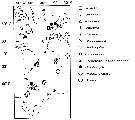 issued from : E.L. Markhaseva & K. Schulz in Mitt. hamb. zool. Mus. Inst., 2008, 105. [p.49, Fig.12]. Distribution géographique des Aetideidae benthopélagiques dans l'iocéan Atlantique, les regions polaires incluses (Markhaseva, 1996, 1997; Markhaseva & Schnack-Schiel, 2003; Markhaseva & Schilz, 2006; Schulz, 2002; Schulz & Markhaseva, 2000, and unpublished original data). |
 issued from : E.L. Markhaseva & V.YU. Razzhivin in Okeanol., 1984, 29 (3). [p.612, Gig.1]. Vertical distribution of the Aetideidae in the Kuril-Kamchatka trench region. Thickness of bars indicates frequency of occurrence (percentage of total number of collections in the depth interval in question); Numbering of the species in circle: 1- Aetideus pacificus; 2- Aetideopsis multiserrata; 3- A. rostrata; 4- A. retusa**; 5- Batheuchaeta animala**; 6- B. gurjanovae; 7- B. hepneri**; 8- B. lamellata; 9- Pseudeuchaeta spinata**; 10- Batheuchaeta peculiaris**; 11- Chiridius pacificus; 12- C. polaris; 13- Chiridiella abyssalis; 14- Ch. bichela**; 15- Ch. gibba**; 16- Ch. pacifica; 17, Ch. smoki**; 18- Ch. subaequalis**; 19- Euchirella curticauda; 20- E. formosa; 21- Gaetanus intermedius; 22- G. paracurvicornis; 23- G. brevispinus; 24- G. brevirostris; 25- G. inermis*; 26- G. robustus; 27- G. tenuispinus; 28- G. minutus; 29- Pseudochirella accepta; 30- P. batillipa*; 31- P. dubia; 32- P. pacifica; 33- P. palliata**; 34- P. obtusa; 35- P. tanakai**. The species not previously identified in the region are marked by a siigle asterisk and those not previously reported in the Pacific by a double asterisk. |
 issued from : E.L. Markhaseva & F.D. Ferrari in Invert. Zool., 2005, 2 (2). [p.162, Table 4] Setation of oral parts in females Aetideidae (Clausocalanoidea) and ancestral condition of setation. |
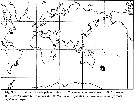 issued from : E.L. Markhaseva in Pelagic Biogeography ICoPB II. Proceedings of the 2nd International Conference. Final report of SCOR/IOC working group 93. Noordwijkerhout, The Netherlands 9-14 July 1995. Workshop Report No.142. UNESCO, 1998. [p.252, Fig.3] Distribution of benthopelagic aetideids in the World Ocean. |
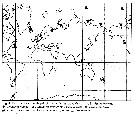 issued from : E.L. Markhaseva in Pelagic Biogeography ICoPB II. Proceedings of the 2nd International Conference. Final report of SCOR/IOC working group 93. Noordwijkerhout, The Netherlands 9-14 July 1995. Workshop Report No.142. UNESCO, 1998. [p.253, Fig.4] Distribution of benthopelagic aetideids in the World Ocean. |
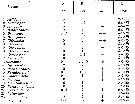 Issued from : E.L. Markhaseva in Marine Plankton II, Explorations of the Fauna of the Seas, 1993, 45 (53). [p.57, Table I] Phylogenetic trends within Aetideidae (Copepoda, Calanoida). Setal armature of A2. A: exopodal segment 1; B: exopodal segment 2; C: medial seta on the exopodal segment 7; Re/Ri: Exopod length/endopodal length ratio. |
 Issued from : E.L. Markhaseva in Marine Plankton II, Explorations of the Fauna of the Seas, 1993, 45 (53). [p.58, Table 2] Phylogenetic trends within Aetideidae (Copepoda, Calanoida). Setal armature of mandibular palp. B2: basipodite 2; Ri: endopod. |
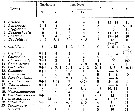 Issued from : E.L. Markhaseva in Marine Plankton II, Explorations of the Fauna of the Seas, 1993, 45 (53). [p.59, Table 3] Phylogenetic trends within Aetideidae (Copepoda, Calanoida). Setal armature of Mx1. Gnathobase: inner lobe 1; B2: distal part of inner side of Ri |
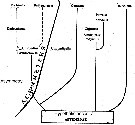 Issued from : E.L. Markhaseva in Marine Plankton II, Explorations of the Fauna of the Seas, 1993, 45 (53). [p.67, Fig.4] Phylogenetic trends within Aetideidae (Copepoda, Calanoida). Ac..... : asymmetry. Three main phylogenetic trends within Aetideidae are revealed: The first is retraced for Aetideus, Paivella, Aetideopsis, Badyidius, Chiridius. Among them Aetideus and Paivella are considered as most specialized; the second; Gaetanus, Pseudochirella, Chirundina, Chirundinella, Undeuchaeta, Euchirella and Batheuchaeta, the later: two genera are the most specialized; the third trend of Aetideidae evolution is represented by Chiridiella which may be a good example of feeding specialization. Epibenthic aetideids show weak resemblance with pelagic ones and are not referred to any of the three mentioned trends, but altogether might be characterized by having in their morphology a mosaic combination of primitive and progressive features. Aetideidae developed by expansion of nearly all pelagic vertical zones and by broadening of feeding types from the mixed type of feeding to predation ( Pseudeuchaeta) or sucking predation ( Chiridiella). |
 issued from : E.L. Markhaseva in Pelagic Biogeography ICoPB II. Proceedings of the 2nd International Conference. Final report of SCOR/IOC working group 93. Noordwijkerhout, The Netherlands 9-14 July 1995. Workshop Report No.142. UNESCO, 1998. [p.252, Fig.2] Distribution of aetideids in the World Ocean. |
 issued from : E.L. Markhaseva in Pelagic Biogeography ICoPB II. Proceedings of the 2nd International Conference. Final report of SCOR/IOC working group 93. Noordwijkerhout, The Netherlands 9-14 July 1995. Workshop Report No.142. UNESCO, 1998. [p.253, Fig.5] Graph of the similarity of total aetideid fauna (pelagic and bentho-pelagic)). |
 issued from : E.L. Markhaseva in Pelagic Biogeography ICoPB II. Proceedings of the 2nd International Conference. Final report of SCOR/IOC working group 93. Noordwijkerhout, The Netherlands 9-14 July 1995. Workshop Report No.142. UNESCO, 1998. [p.251, Fig.1] Latitudinal zones of the World Ocean pelagial. The geographical subdivision of the pelagic is given according to Nesis, 1982 (in Zoogeography of the World Ocean: comparison of the pelagic zonality and the shelf regional subdivision. In: O.G. Kussakin ed. Marine Biogeography. Nauka, Moskva: 114-134). The similarity of faunas in the different geographical zones of the world Ocean was examined with the use of Sorensen's index of similarity (IS) and Simpson's index of inclusion (II) of less diverse fauna into the richer one. Four types of aetideid copepod distributions are denoted: 1 - Cosmopolitan genera: 7 genera, of which Euchirella is only absent in the Arctic Ocean. The mainly pelagic genera: Gaetanus, Pseudochirella, Euchirella, Aetideopsis, Chiridiella, Chiridius, Pseudeuchaeta. 2 - Tropico-boreal genera: Three pelagic genera Aetideus, Chirundina, Undeuchaeta and two benthopelacic genera Bradyidius, Comantenna. 3 - Genera found within tropical limits: Two pelagic genera Chirundinella, Paivella and five benthopelagic genera Crassantenna, Lutamator, Mesocomantenna, Paracomantenna, Sursamucro. 4 - Benthopelagic genera: Three benthopelagic genera are registered within the limits of the Arcto-boreal Jaschnovia is found in both arctic and boreal zones; Bradyetes is known from the boreal Atlantic and Azygokeras from the boreal Pacific. The pelagic genera demonstrate wide distributions, whereas 8 benthopelagic genera are mostly endemic. Comparison of faunas: The tropical Pacific aetideid fauna is the richest with 98 species, followed by the tropical Atlantic fauna with 73 species, and the tropical Indian Ocean fauna with 50 species. nearly equal in species number are the boreal Atlantic (57 species) and boreal Pacific (53 species) faunas. The Subantarctic fauna (Not) includes 30 species and the Antarctic and Arctic faunas contain 29 and 14 species respectively. The results of the analyses of the total aetideid fauna show a high degree of similarity between tropicalAtlantic, tropical Pacific and tropical Indian ocan faunas (IS = 56 to 62 %) and between each of these fauna with fauna of boreal Atlantic (IS = 54 to 58 %) The degree of similarity between Subantarctic and Antarctic faunas is also high (IS = 61 %). An aetideid fauna of the upper 500 m layer is nearly absent in Polar basins (see fig.6). Few aetideid species occur in the upper layers in Polar basins. Nevertheless they are typical of deeper layers in the other regions of the Wiorld Ocean and it are most likely meso-, bathy-, or meso-/bathypelagic species. The tropical faunas are significantly similar to each other (IS = 63 to 77 %) and to the boreal Atlantic fauna (IS = 67 to 78 %). The latter is also similar to the Subantarctic fauna (IS = 57 %). The faunas of the tropical Atlantic and Indian Oceans are related to the tropical Pacific fauna (for the tropical Atlantic II = 81 %, the latter includes the total fauna) and the boreal Atlantic fauna is related to the tropical faunas with II values of 73 % to 93 %. The fauna of the Subantarctic is totally included into the boreal Atlantic fauna. The boreal Pacific fauna is poor in comparison to tropical faunas , and in this respect it is separated more clearly than the boreal Atlantic fauna. The similarity between the boreal Pacific and boreal Atlantic faunas is weak; and similarity is even smaller between boreal Pacific and Subantarctic zones. The deep water aetideid fauna exists in Polar basins (10 species in Arctic and 22 species in Antarctic zones (see fig.7). The similarity between these faunas is moderate (IS = 38 %), and due to the presence of the bipolar species ( Aetideopsis minor, Pseudochirella batillipa, P. spectabilis), and the cosmopolitan species Gaetanus brevispinus, G. tenuispinus. The arctic fauna is poor and has weak similarity to boreal and tropical faunas (IS = 21 to 24 %) The boreal faunas of deep water aetideids are rather similar (IS = 52 %). The boreal Atlantic deep water fauna is related to the boreal Pacific fauna. It is very possible that boreal faunas originated from tropical faunas, but the boreal Pacific fauna probably is older than the boreal Atlantic. The boreal Pacific deep water fauna has higher similarity with the deep water aetideid fauna of the tropical Pacific (IS = 51 %) than with the upper layer aetideid faunas. The similarity of the boreal Pacific fauna with the tropical Atlantic and Indian Ocean faunas, is weak and this is comparable with the above mentioned similarity for the upper layer aetideids. The distribution of deep water aetideids showed that they have significantly more similarities than the faunas of the upper layers. The fact that the tropical Pacific fauna is the richest suggests that it is the most ancient among aetideid fauna. |
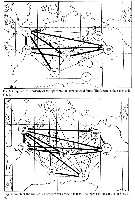 issued from : E.L. Markhaseva in Pelagic Biogeography ICoPB II. Proceedings of the 2nd International Conference. Final report of SCOR/IOC working group 93. Noordwijkerhout, The Netherlands 9-14 July 1995. Workshop Report No.142. UNESCO, 1998. [p.254, Figs.6, 7] Graphs of the similarity. of aetideids. |
 Issued from : G.A. Boxshall & S.H. Halsey in An Introduction to Copepod Diversity. The Ray Society, 2004, Part I, No 166. [p.54]. Armature formula of swimming legs P1 to P4. Nota: Swimming legs P1 to P4 biramous, typically with 3-segmented rami, except P1 with 1-segmented endopod and P2 with 1 or 2-segmented endopod. -P1 exopod 1-segmented in Chiridiella or 2-segmented in some species of Gaetanus and Euchirella; additional segmental fusions sometimes present, as between proximal exopodal segments of valdiviella species. - Coxa of P4 ornamented with cluster of spinules near base of inner seta; with 2 transverse rows of 4 to 6 spinules in Paivella, but usually lacking surface ornamentation except for scattered spinules. Inner seta on basis of P1 situated on anterior surface of basis and passing across face of 1st endopodal segment. Seration sometimes reduced or modified, only 2 outer spines on distal exopodal segments of P2 to P4 in Senecella calanoides Juday. Terminal spines on exopods of P2 to P4 with conspicuous dentate outer margin. - P5 usually absent in females, rarely represented by biramous vestige, as in Comantenna recurvata Grice & Hulsemann, or by segmented vestige as in Pseudotharybis, Parabradyidius and some specimens of Sursamucro and Aetideopsis. - Male P5 typically asymmetrical; often elongate, with styliform distal segments on exopods. Right leg typically biramous with up to 3-segmented exopod and 1-segmented endopod, rarely absent as in Aetideus. Left leg biramous with up to 3-segmented exopod and 1-segmented endopod. P5 highly variable; both may be uniramous, lacking endopods. Endopods rarely 2-segmented as in Parabradyidius angelikae Schulz & Markhaseva, Bradyetes matthei Johnnessen, Bradyidius arnoldi Fleminger and Comantenna brevicornis (Boeck). - Eggs retained in paired multiseriate sacs, at least in some species; rarely in uniseriate sacs as in Euchirella pseudopulchra Park. |
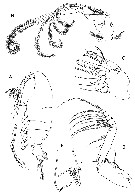 Issued from : G.A. Boxshall & S.H. Halsey in An Introduction to Copepod Diversity. The Ray Society, 2004, Part I, No 166. [p.55, Fig.3]. Aetideidae. A, Euchirella messinensis habitus female; B, A2; C, Mx2; D, Mxp; E, Pseudochirella pustulifera protopod* of P4. [von Vaupel Klein, 1982b: A-D; Sars, 1924: E]. *: protopod = the basal part of a limb (praecoxa+coxa+ basis) that carries the rami. |
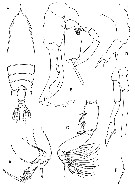 Issued from : G.A. Boxshall & S.H. Halsey in An Introduction to Copepod Diversity. The Ray Society, 2004, Part I, No 166. [p.59, Fig.4]. Aetideidae. A, Gaetanus pileayus habitus female; B, Chiridiella macrodactyka Mx2; C, Comantenna brevicornis (as Bryaxis brevicornis) Mxp; D, Pseudotharybis brevispinus female P5; E, Ubdeuchaeta incisa male P5; F, Chiridius subgracilis male P5. [Sars, 1924: A-B; Sars, 1902: C; Bradford & Jillett, 1980: D-F]. |
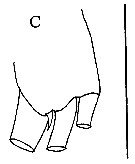 Issued from : E.L. Markhaseva & J. Renz in Crustaceana, 2015, 88 (9). [p.1043, Fig.6, C]. Aetideopsis armata. Female: C, Mx2 praecoxal endite. |
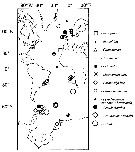 Issued from : E.L. Markhaseva & K. Schulz in Mitt. hamb. zool. Mus. Inst., 2008, 105. [p.49, Fig.2]. Geographical distribution of benthopelagic Aetideidae in the Atlantic Ocean including Polar regions (Markhaseva, 1996, 1997; Markhaseva & Schnack-Schiel, 2003; Markhaseva & Schulz, 2006; Schulz, 2002; Schulz & Markhaseva, 2000; Markhaseva & Schulz, 2008, and unpublished original data). |
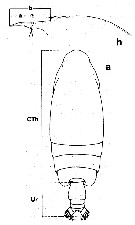 Issued from : J.C. von Vaupel Klein in Crustaceana, (Supplement) 9, 1984. [p.59, Fig.3, a, h]. a, measurements taken of cephalosome (CTh) and urosome (Ur) to compare CTh/Ur length ratio; h, two possibilities to determine the length of the rostrum. Characters used in Table I for cluster analysis. |
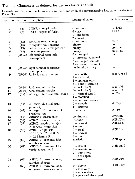 Issued from : J.C. von Vaupel Klein in Crustaceana, (Supplement) 9, 1984. [p.87, Table I]. Characters as defined for use in cluster analysis. Symbols used (coding of states): - CTh: cephalosome. - Ur : urosomites 1 to 4. - A1: antennule. - A2: antenna; - Md: mandible; - Mx1: maxillule. - Max: Mx2, maxilla; - Mxp: maxilliped. - P1 to P4: swimming legs 1 to 4. Ri: endopod. Re: exopod. Ba1: basipod 1 (= coxa). Ba2: basipod 2 (= basis). E: endites. Gnsom: genital somite. |
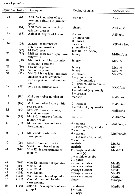 Issued from : J.C. von Vaupel Klein in Crustaceana, (Supplement) 9, 1984. [p.88, Table I (cont'd)]. Characters as defined for use in cluster analysis. |
 Issued from : J.C. von Vaupel Klein in Crustaceana, (Supplement) 9, 1984. [p.89, Table I (cont'd)]. Characters as defined for use in cluster analysis. |
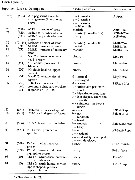 Issued from : J.C. von Vaupel Klein in Crustaceana, (Supplement) 9, 1984. [p.90, Table I (cont'd)]. Characters as defined for use in cluster analysis. |
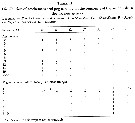 Issued from : J.C. von Vaupel Klein in Crustaceana, (Supplement) 9, 1984. [p.97, Table III]. Distribution of aesthetascs and peg-sensilla on the segments of the antennule (A1) in the various genera. |
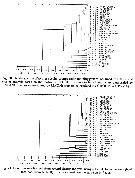 Issued from : J.C. von Vaupel Klein in Crustaceana, (Supplement) 9, 1984. [p.96, Figs. 20, 21]. Dendogram of Euchirella species-groups and remaining genera, obtained from the initial cluster analysis based on the matrix of the species studied. | | | | | Aetideinae Brodsky, 1950 | | Ref.: | Brodsky, 1950 (1967) (p.142): 12 genres y sont inclus: Aetideopsis, Aetideus, Bryaxis, Chiridius, Derjuginia, Euaetideus, Gaetanus, Gaidiopsis , Gaidius, Pseudaetideus, Pseudogaetanus, Undinopsis.
Vaupel Klein, 1984 a (p.56) ajoute aux genres précédents: Bradyidius, Comantenna, Crassantenna, Lutamator, Paivella, Paracomantenna, Pseudotharybis, Snelliaetideus, Sursamucro, Wilsonidius,? Pseudeuchaeta , ? Valdiviella.
Razouls,1982 (p.153); Zheng Zhong & al.,1984 (1989)(p.235, clé des G.); Mauchline,1988 (p.726, 729: pores cuticulaires) | | | | Euchirellinae Brodsky, 1950 | | Ref.: | Brodsky, 1950 (1967) (p.170) y inclut 5 genres : Batheuchaeta , Chirundina, Euchirella , Pseudochirella , Undeuchaeta. Vaupel Klein, 1984 a (p.55, 56) y ajoute : Chirundinella.
Razouls, 1982 (p.153); Mauchline, 1988 (p.731: pores cuticulaires); Zheng Zhong & al., 1984 (1989) (p.235, clé G.); Vaupel Klein & Rijerkerk, 1996 (p.567)
| | | | (1) Aetideopsis Sars, 1903 ( Aetideinae ) | |
| | Syn.: | Pseudaetideus Wolfenden,1904 (p.115); Brodsky, 1950 (1967) (p.156); Faroella Wolfenden, 1904 (p.117); 1911 (p.213) | | Ref.: | Sars, 1903 (p.159); van Breemen, 1908 a (p.33); A. Scott, 1909 (p.40); Esterly, 1911 (p.314); With, 1915 (p.72, 73); Sewell; 1929 (p.99); Wilson, 1932 a (p.46); Rose, 1933 a (p.90); Davis,1949 (p.25); Brodsky, 1950 (1967) (p.146); Vervoort, 1952 (n°41, p.2); 1952 a (n°42, p.3); Vervoort, 1957 (p.52, Rem.); Tanaka, 1957 a (p.37); Bradford, 1969 (p.73, 92, 95, Rev.); Park, 1975 b (p.272); Bradford, 1976 a (p.9, Rem.); Park, 1978 (p.111, clé spp.); Bradford & Jillett, 1980 (Def., p.17); Shih & Maclellan, 1981 (p.567); Razouls, 1982 (p.162); Mauchline, 1988 (p.726); Ferrari, 1992 (p.392, tab.3); Razouls,1993 (p.309); Markhaseva,1993 (p.54 & foll.); 1996 (p.26, spp Key., Rem.); Chihara & Murano, 1997 (p.681, spp. Key); Mauchline, 1998 (p.88, 92: F; p.92: M); Bradford-Grieve & al., 1999 (p.918, 920: spp. key); Bradford-Grieve, 2004 (p.287); Boxshall & Halsey, 2004 (p.57: F; 60: M); Vives & Shmeleva, 2007 (p.536, spp. Key) | | Rem.: | type: Aetideopsis rostrata Sars,1903.
12 spp. + 1 indet. | | Remarques sur les dimensions et le sex-ratio: | | The mean female size is 3.05 mm (n = 26; SD = 0.687; Cv= 0.8324), and the mean males size 2.979 mm (n = 16; SD = 0.6660). The size ratio Male:Female is 0.851. The sex ratio (F:M) is 1.44. | | | | (2) Aetideus Brady, 1883 ( Aetideinae ) | |
| | Syn.: | Aetidius Brady, 1883 (p.75); Giesbrecht, 1892 (p.53); Wolfenden,1911 (p.207);
Euaetideus Sars, 1925 (p.42); Park,1978 (p.105); Mulyadi, 2004 (p.59);
Snelliaetideus Vervoort,1949 (p.3) | | Ref.: | Giesbrecht & Schmeil, 1898 (p.31); Sars, 1901 a (1903) (p.24); Esterly, 1905 (p.144); van Breemen, 1908 a (p.29); A. Scott, 1909 (p.36); With, 1915 (p.72 & suiv.); Sewell, 1929 (p.99); Wilson, 1932 a (p.44); Rose, 1933 a (p.89); Mori, 1937 (1964) (p.37); Davis, 1949 (p.24); Brodsky, 1950 (1967) (p.144); Vervoort, 1952 (n°41, p.2); 1952 a (n°42, p.3); Tanaka, 1957 a (p.31); Vinogradov, 1968 (1970) (p.109); Bradford, 1971 (p.12, 32, Def., spp. Key); 1972 (p.26, 28); Park, 1974 (p.215, Rem.); Roe, 1975 (p.305); Park, 1978 (p.104); Bradford & Jillett, 1980 (p.11, 14, Def.,); Razouls, 1982 (p.158); Gardner & Szabo, 1982 (p.199, Rem.); Mauchline, 1988 (p.726); Zheng Zhong & al., 1984 (1989) (p.235); Razouls, 1993 (p.309); Markhaseva, 1993 (p.54 & suiv.); 1996 (p.11, spp. Key, Rem.); Chihara & Murano, 1997 (p.682, spp. Key); Mauchline, 1998 (p.92: F; p.92: M); Bradford-Grieve & al., 1999 (p.879, 918, 920: spp. Key); Boxshall & Halsey, 2004 (p.57: F; 60: M); Vives & Shmeleva, 2007 (p.542, spp. Key) | | Rem.: | type: Pseudocalanus armatus Boeck,1872. 11 spp.: | | Remarques sur les dimensions et le sex-ratio: | | The mean female size is 1,822 mm (n= 22; SD = 0.3671) and the mean male size is 1,562 (n = 19; SD = 0.2996). The size ratio Male:Female is 0.957. The sex-ratio (F/M) is 1,1. | | | | (3) Azygokeras Koeller & Littlepage, 1976 | |
| | Ref.: | Koeller & Littlepage, 1976 (p.1548); Razouls, 1982 (p.230); Gardner & Szabo, 1982 (p.255, Rem.); Razouls, 1993 (p.309); Markhaseva, 1993 (p.54 & suiv.); 1996 (p.47); Mauchline, 1998 (p.80: F; p.81: M); Bradford-Grieve, 2004 (p.287); Boxshall & Halsey, 2004 (p.58: F; 60: M) | | Rem.: | type: Azygokeras columbiae . 1 sp.: | | | | (4) Batheuchaeta Brodsky, 1950 ( Euchirellinae ) | |
| | Ref.: | Brodsky, 1950 (1967) (p.190); Bradford & Jillett, 1980 (Def., p.21); Markhaseva, 1981 (p.1151, 1152, spp.Key F); Razouls, 1982 (p.227); Markhaseva, 1986 a (p.837, spp. Key F,M); Vaupel Klein, 1984 a (p.50, Rem.); Mauchline, 1988 (p.731); Razouls, 1993 (p.309); Markhaseva, 1993 (p.54 & follo.); 1996 (p.50, spp. Key); Mauchline, 1998 (p.88: F; p.90: M); Boxshall & Halsey, 2004 (p.58: F; 60: M) | | Rem.: | type: Batheuchaeta lamellata Brodsky,1950. 9 spp.: | | Remarques sur les dimensions et le sex-ratio: | | The mean female size is 4.616 mm (n = 12; SD = 0.3713), and the mean male size is 4.160 mm (n = 5; SD = 0.2219 ). The size ratio Male:Female is 0.901. The sex ratio (F:M) is 2, value not exceptional for the deep-living species. | | | | (5) Bradyetes Farran, 1905 | |
| | Ref.: | Farran, 1905 (p.31); van Breemen, 1908 a (p.32); With, 1915 (p.73); Rose, 1933 a (p.92); Sewell, 1947 (p.104-106, Rem.); Brodsky, 1950 (1967) (p.142); Vervoort, 1952 (n°41, p.2); 1952 b (n°43, p.3); Grice, 1972 a (p.224, Rem.); Bradford & Jillett, 1980 (Def., p.21); Razouls, 1982 (p.157); Vaupel Klein, 1984 a (p.56); Razouls, 1993 (p.309); Markhaseva, 1993 (p.54 & suiv.); 1996 (p.62, spp. Key, Rem.); Mauchline, 1998 (p.88: F; p.90: M); Markhaseva & Schnack-Schiel, 2003 (p.116, Rem.); Bradford-Grieve, 2004 (p.287); Boxshall & Halsey, 2004 (p.58: F; 60: M); Ohtsuka & al., 2005 (p.226, Rem.); Vives & Shmeleva, 2007 (p.549); Renz & Markhaseva, 2015 (p.96, Table 4, fig.3, sex ratio, biogeography) | | Rem.: | Type: Bradyetes inermis Farran,1905. Ce genre pourrait être synonyme de Pseudeuchaeta (in Sewell, 1947) ce qui est infirmé par Grice (1972 a).
6 spp. | | Remarques sur les dimensions et le sex-ratio: | | The mean female size is 3.471 mm (n = 8; SD = 1.2439), and that of the males 2.040 mm (n = 3; SD = 0.763). The size-ratio Male:Female is 0.588. The sex ratio is 2.5. | | | | (6) Bradyidius Giesbrecht, 1897 ( Aetideinae ) | |
| | Syn.: | Pseudocalanus (part.) : Brady, 1878 (p.46), non Boeck, 1872;
Undinopsis Sars, 1884 (nomen nudum ); 1902 (1903) (p.31); Rose, 1933 a (p.91); Brodsky, 1950 (1967) (p.150) | | Ref.: | Giesbrecht, 1897 b (p.253); Giesbrecht & Schmeil, 1898 (p.32); van Breemen, 1908 a (p.31); A. Scott,1909 (p.39); Mori, 1937 (1964) (p.39); C.B. Wilson, 1950 (p.172, Rem.); Vervoort, 1952 b (p.3); Matthews, 1964 (p.18, Rem.); Bradford, 1969 (p.86, 92, 95, Def.); 1969 b (p.476, 502); 1976 a (p.1, 6, 9); Campaner, 1978 (p.871); Bradford & Jillett, 1980 (Def., p.21); Razouls, 1982 (p.168); Gardner & Szabo, 1982 (p.205, Rem.); Alvarez, 1984 (p.96); Othman & Greenwood, 1987 (p.1137, 1140); Mauchline, 1988 (p.728); Razouls, 1993 (p.309); Ferrari, 1992 (p.392, tab.3); Markhaseva, 1993 (p.54 & suiv.); 1996 (p.68, clé spp., Rem.); Chihara & Murano, 1997 (p.683); Mauchline, 1998 (p.80, 88, 92: F; p.80, 92, 93: M); Markhaseva & Schnack-Schiel, 2003 (p.119, Rem.); Bradford-Grieve, 2004 (p.287); Boxshall & Halsey, 2004 (p.57: F; 60: M); Vives & Shmeleva, 2007 (p.549); Renz & Markhaseva, 2015 (p.96, Table 4, fig.3, sex ratio, biogeography) | | Rem.: | Type: Bradyidius armatus Giesbrecht,1897. 16 spp.(dont 1 douteuse) + 2 indet.: | | Remarques sur les dimensions et le sex-ratio: | | The mean female size is 2.558 mm (n = 28; SD = 0.7813), and for the males 1.908 mm (n = 21; SD = 0.6377). The size ratio Male: Female is 0.746. The sex ratio (F:M) is 1.25. |  issued from : B.H.R. Othman & J.G. Greenwood in J. Plankton Res., 1987, 9 (6). [p.1137, Table I]. Comparison of some characterristics of 13 species of Bradyidius. |
 issued from : E.L. Markhaseva in Pelagic Biogeography ICoPB II. Proceedings of the 2nd International Conference. Final report of SCOR/IOC working group 93. Noordwijkerhout, The Netherlands 9-14 July 1995. Workshop Report No.142. UNESCO, 1998. [p. 252, Fig.2] Distribution of Bradyidius in the World Ocean. |
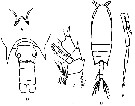 Issued from : F. Vives & A.A. Shmeleva in Fauna Iberica, 2007, 29. [p.551, Fig. 300]. Bradyidius armatus after Sars, 1902; Markhaseva, 1996.
Female: A, rostrum; B, posterior corners of prosome and urosome (dorsal view); C, P2.
Male: D, habitus (dorsal view); E, P5. | | | | | Bryaxis Sars, 1902 ( Aetideinae ) | |
| | Ref.: | Sars, 1902 (1903) (p.35); van Breemen, 1908 a (p.37); With, 1915 (p.73); Rose, 1933 a (p.101); Sewell, 1947 (p.104,105); Brodsky 1950 (1967) (p.143); Vervoort, 1952 b (n°43,p.3); Campaner, 1978 (p.872); Bradford & Jillett, 1980 (p.27); Razouls, 1982 (p.195); 1993 (p.309) | | Rem.: | Nom du genre établi par Boeck,1872 mais non publié par cet auteur. Cf. Comantenna (part.) & Paracomantenna (part.) | | | | (7) Chiridiella G.O. Sars, 1907 | |
| | Ref.: | Sars, 1907 (p.7); A. Scott, 1909 (p.78); Wolfenden, 1911 (p.292); Sars, 1925 (p.50); Sewell, 1929 (p.101); Rose, 1933 a (p.95); Brodsky, 1950 (1967) (p.142, 192, clé spp.); Vervoort, 1952 (n°41, p.2); 1952 c (p.3); Tanaka, 1957 a (p.56); Bradford, 1971 b (p.20, clé spp.F); Deevey, 1974 (p.439, 468, Rev., clé spp.F); Park, 1978 (p.127); Bradford & Jillett, 1980 (Def., p.22); Razouls, 1982 (p.154); Mauchline, 1988 (p.726); Razouls, 1993 (p.309); Markhaseva, 1993 (p.54 & suiv.); 1996 (p.81, clé spp., Rem.); Chihara & Murano, 1997 (p.683); Mauchline, 1998 (p.66, 77: F,M; p.88: F; p.90, 93: M); Boxshall & Halsey, 2004 (p.58: F; 60: M); Vives & Shmeleva, 2007 (p.556, spp. Key) | | Rem.: | Type: Chiridiella macrodactyla Sars,1907. 18 spp.: | | Remarques sur les dimensions et le sex-ratio: | | La moyenne des longueurs des femelles est de 3,096 mm (n= 17; S= 0,655; Cv= 0,212). La moyenne pour les 2 mâles connus est de 2,850 mm. Le rapport M/F établi dans ce cas est de 1,041. Le sex-ratio est fortement en faveur des femelles correspondant à leur positionnement bathypélagique. | | | | (8) Chiridius Giesbrecht, 1892 ( Aetideinae ) | |
| | Syn.: | Euchaeta (part.) Boeck, 1872; Giesbrecht, 1892 (p.301); ? Pseudaetideus Wolfenden, 1904 (p.115: Rem.); Wilson, 1932 a (p.548); Brodsky, 1950 (1967) (p.156); Vervoort, 1952 c (n°44, p.3); Chiridius (part.) : Farran, 1929 (p.230); | | Ref.: | Giesbrecht, 1892 (p.54, 224); Giesbrecht & Schmeil, 1898 (p.33); van Breemen, 1908 a (p.34); Sars, 1900 (p.63); 1901 a (1903) (p.27); A. Scott, 1909 (p.41); Wolfenden, 1911 (p.210); With, 1915 (p.63); Sewell, 1929 (p.100); Wilson, 1932 a (p.47); Rose, 1933 a (p.93); Brodsky, 1950 (1967) (p.152, clé spp.); Vervoort, 1952 c (n°44, p.3); Tanaka, 1957 a (p.47); Matthews, 1964 (p.6, Rem.); Tanaka & Omori, 1970 (p.117, Rem.); Park, 1975 (p.279, clé spp.); 1978 (p.122, Rem.); Bradford & Jillett, 1980 (Def., p.23); Razouls, 1982 (p.172); Gardner & Szabo, 1982 (p.211, Rem.); Mauchline, 1988 (p.729); Ferrari, 1992 (p.392, tab.3); Razouls, 1993 (p.309); Markhaseva, 1993 (p.54 & suiv.); 1996 (p.108, clé spp., Rem.); Chihara & Murano, 1997 (p.683); Mauchline, 1998 (p.89, 92: F; p.90: M); Bradford-Grieve & al., 1999 (p.919, 920: clé spp.); Bradford-Grieve, 2004 (p.287); Boxshall & Halsey, 2004 (p.58: F; 60: M); Vives & Shmeleva, 2007 (p.552, spp. Key) | | Rem.: | Type: Chiridius poppei Giesbrecht,1892. Tous les auteurs n'admettent pas la synonymie entre Chiridius et Pseudaetideus. 8 spp. : | | Remarques sur les dimensions et le sex-ratio: | | The mean female size is 2,820 mm (n = 14; SD = 0.8742) and for the males 2,479 mm (n = 13; SD = 0.7435). The size ratio Male:Female is 0.879. The sex ratio (F:M) is 1. | | | | (9) Chirundina Giesbrecht, 1895 ( Euchirellinae ) | |
| | Syn.: | Chirudina : With, 1915 (p.74); Wilsonidius Tanaka, 1969 (p.266); Bradford & Jillett, 1980 (p.92) | | Ref.: | Giesbrecht, 1895 c (p.249); Giesbrecht & Schmeil, 1898 (p.34); Esterly, 1906 a (p.58); van Breemen, 1908 a (p.45); A. Scott, 1909 (p.43); Wolfenden, 1911 (p.241); Sars, 1925 (p.76); Sewell, 1929 (p.119); Wilson, 1932 a (p.48); Rose, 1933 a (p.106); Brodsky, 1950 (1967) (p.180); Vervoort, 1952 (n°41, p.2); 1952 h (n°49, p.3); Tanaka, 1957 b (p.190); Park, 1978 (p.176); Bradford & Jillett, 1980 (Def., p.27); Razouls, 1982 (p.214); Gardner & Szabo,1982 (p.243); Vaupel Klein, 1984 a (p.51, Rem.); Mauchline, 1988 (p.731, cuticular pores); Razouls, 1993 (p.309); Markhaseva, 1993 (p.54 & suiv.); 1996 (p.129, spp. Key, Notes. p.129); Chihara & Murano, 1997 (p.684); Mauchline, 1998 (p.92: F; p.93: M); Boxshall & Halsey, 2004 (p.57: F; 61: M); Mulyadi, 2004 (p.54); Vives & Shmeleva, 2007 (p.558) | | Rem.: | Type: Chirundina streetsii Giesbrecht,1895. 3 spp. + 1 douteuse: | | Remarques sur les dimensions et le sex-ratio: | | The mean female size is 4.470 mm (n = 5; SD = 1.0183) and that of the males 4.113 mm (n = 4; SD = 0.7793). The size ratio Male:Female is 0.920. The sex ratio F:M = 1.5. | | | | (10) Chirundinella Tanaka, 1957 ( Euchirellinae ) | |
| | Ref.: | Tanaka, 1953 (p.131: nom. nudum ); 1957 b (p.197, Def.); Bradford & Jillett, 1980 (Def., p.27, 66); Razouls, 1982 (p.228); Vaupel Klein, 1984 a (p.51, Rem.); Razouls, 1993 (p.309); Markhaseva, 1993 (p.54 & suiv.); 1996 (p.135, Rem.); Chihara & Murano, 1997 (p.684); Mauchline, 1998 (p.88: F; p.90: M); Boxshall & Halsey, 2004 (p.57: F; 60: M) | | Rem.: | Type: Chirundinella cara Tanaka,1957. 1 sp.: | | | | (11) Comantenna Wilson, 1924 ( Aetideinae ) | |
| | Syn.: | Bryaxis Sars, 1902 (1903) (p.35); Bryaxona Strand, 1929 | | Ref.: | Wilson, 1924 (p.14, Rem.); Bradford, 1969 b (p.484, 502); Campaner, 1978 (Def., p.872); Bradford & Jillett, 1980 (Def., p.27); Razouls, 1982 (p.196); 1993 (p.309); Markhaseva, 1993 (p.54 & suiv.); Alvarez, 1986 (p.858, 876: Rem.); Markhaseva, 1996 (p.135, clé spp., Rem.); Mauchline, 1998 (p.88: F; p.90: M); Markhaseva & Schnack-Schiel, 2003 (p.116, 118, Rem.); Bradford-Grieve, 2004 (p.287); Boxshall & Halsey, 2004 (p.58: F; 60: M); Renz & Markhaseva, 2015 (p.96, Table 4, fig.3, sex ratio, biogeography) | | Rem.: | type: Bryaxis brevicornis . 5 spp. : | | Remarques sur les dimensions et le sex-ratio: | | The mean female size is 2.841 mm (n = 7; SD = 0.9157); but there seem to be two size groups species (numbered 1, 3, 4) 2.175 mm and (species numbered 2, 5) 3.775 mm, corresponding no doubt to the sampling depths. The sex ratio is strongly biased in favor of the females. | | | | (12) Crassantenna Cole, Green, Croft & Rawlins, 1972 ( Aetideinae ) | |
| | Ref.: | Bradford, 1969 b (p.493, 502); Cole & al., 1972 (in Zool. Rec., 106, section 10, p.194); Bradford & Jillett, 1980 (Def., p.29); Razouls, 1982 (p.229); 1993 (p.309); Markhaseva, 1993 (p.54 & suiv.); 1996 (p.143, clé spp., Rem.); Mauchline, 1998 (p.89: F); Bradford-Grieve, 2004 (p.287); Boxshall & Halsey, 2004 (p.58); Renz & Markhaseva, 2015 (p.96, Table 4, fig.3, biogeography) | | Rem.: | Type: Crassantenna comosa. Les pattes natatoires ne sont pas intactes chez les deux espèces à l'origine de ce genre. Total: 2 spp. | | Remarques sur les dimensions et le sex-ratio: | | The mean female size is 3.667 mm (n = 3; SD = 0.3055. No male known. | 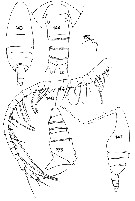 Issued from : J/. Bradford in N. Z. J. Mar. Freshw. Res., 1969, 3 (4). [p.494,
Figs. 143, 144, 147, 148, 163]. Crassantenna comosaFemale: 143, habitus (dorsal view); 144, urosome (dorsal view); 147, habitus (lateral view); 148, A1; 153, urosome (lateral view). | | | | | Derjuginia Jaschnov, 1947 ( Aetideinae ) | |
| | Ref.: | Brodsky, 1950 (1967) (p.157); Bradford & Jillett, 1980 (Def.,p.29); Markhaseva, 1980 a (p.63); Razouls, 1982 (p.177); 1993 (p.309) | | Rem.: | Cf. Jaschnovia | | | | Euaetideus Sars, 1925 ( Aetideinae ) | | Ref.: | Sars, 1925 (p.42); Rose, 1933 a (p.90); Brodsky, 1950 (1967) (p.143); Vervoort, 1952 a (n°42, p.3); Bradford, 1971 (p.12 & suiv., Rem.); Park, 1978 (p.105, Rem.); Bradford & Jillett, 1980 (p.11, 14, Rem.); Razouls, 1982 (p.197); 1993 (p.309) | | Rem.: | type: Aetideus giesbrechti Clève,1904. Cf. Aetideus | | | | (13) Euchirella Giesbrecht, 1888 ( Euchirellinae ) | |
| | Ref.: | Giesbrecht, 1892 (p.54, 232); Giesbrecht & Schmeil, 1898 (p.34, spp. Key); Esterly, 1905 (p.150, spp. Key); Wolfenden, 1905 a (p.17); van Breemen, 1908 a (p.46); A. Scott, 1909 (p.53); Wolfenden, 1911 (p.234); With, 1915 (p.72 & suiv.); Sars, 1925 (p.65); Sewell, 1929 (p.106, Rem.); Wilson, 1932 a (p.55, clé spp.); Rose, 1933 a (p.102, spp. Key); Mori, 1937 (1964) (p.41); Sewell, 1947 (p.69, 70: 2 groups); Davis, 1949 (p.29); Brodsky, 1950 (1967) (p.171, spp. Key); Vervoort, 1952 (n°41, p.2); 1952 f (n°41, p.3); 1957 (p.63, 64, Rem.); Tanaka, 1957 b (p.176); Vervoort, 1963 b (p.134, Rem.); Owre & Foyo, 1967 (p.45, spp. Key); Tanaka & Omori, 1969 (p.33); 1969 a (p.155); Park, 1976 a (p.101, Rev., clé spp.); Vaupel Klein, 1972 (p.497, Rev.); Park, 1978 (p.147); Vaupel Klein, 1980 (p.151 & suiv.); Bradford & Jillett, 1980 (Def., p.30); Razouls, 1982 (p.201); Gardner & Szabo, 1982 (p.233); Vaupel Klein, 1984 a (.p.33, 164 female: Def., Rev., Key to the Species-Groups females: p.166); Mauchline, 1988 (p.730); Zheng Zhong & al., 1984 (1989) (p.235); Ferrari, 1992 (p.392, tab.3); Razouls, 1993 (p.309); Markhaseva, 1993 (p.54 & suiv.); 1996 (p.145, spp. Key, Rem.); Chihara & Murano, 1997 (p.684, spp. Key); Mauchline, 1998 (p.92: F; p.93: M); Vaupel Klein, 1998 (p.153, Rem.: phylogeny, Key); 1998 a (p.383 & suiv., Rem. speciation); Bradford-Grieve & al., 1999 (p.919, 921: clé spp.); Boxshall & Halsey, 2004 (p.57, 58 F; 60, 61: M); Mulyadi, 2004 (p.40); Vives & Shmeleva, 2007 (p.560, spp. Key) | | Rem.: | Type: Undina messinensis Claus,1863. 24 spp.
La distribution bathymétrique de ces formes montre généralement une très grande amplitude. | | Remarques sur les dimensions et le sex-ratio: | | The mean female size is 4,780 mm (n = 48; SD = 1.3573), and that of the males 4,282 mm (n = 33; SD = 1.1607). The size ratio Male:Female is 0,896. The sex ratio is 1,33. |  issued from : J.C. von Vaupel Klein in Crustaceana, Supplt 9, Studies on Copepoda, III, 1984. [p.168]. Females. Légende: voir version anglaise. |
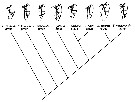 issued from : J.C. von Vaupel Klein in Zool. Verh. Leiden, 1998, 323. [p.384, Fig.1]. General body shape of the females and putative phylogenetic relationships among the eight species-groups recognized in Euchirella. (modified from Von Vaupel Klein, 1984).. | | | | | (14) Gaetanus Giesbrecht, 1888 ( Aetideinae ) | |
| | Syn.: | Gaëtanus Giesbrecht, 1888 (p.335);
Chiridius (part) Sars;
Mesogaidius (part.) Wolfenden, 1911 (p.223);
Pseudogaetanus Brodsky, 1950 (1967) (p.143, 144, 169);
Gaidius Giesbrecht, 1895 c (p.249); Giesbrecht & Schmeil, 1898 (p.32); Sars, 1903 (p.161); Esterly, 1905 (p.145); van Breemen, 1908 a (p.35); A. Scott, 1909 (p.51); Wolfenden, 1911 (p.222); With, 1915 (p.72 & suiv.); Sars, 1925 (p.46, 57); Sewell, 1929 (p.100); Wilson, 1932 a (p.52); Rose, 1933 a (p.96, clé spp.); Davis, 1949 (p.26); Brodsky, 1950 (1967) (p.158, spp. Key); Vervoort, 1952 (n°41, p.2); 1952 d (n°45, p.3); Tanaka, 1957 a (p.60); Park, 1975 a (Rev., p.9,10); Park, 1978 (p.127); Bradford & Jillett, 1980 (Def., p.57); Razouls, 1982 (p.178); Gardner & Szabo, 1982 (p.217); Mauchline, 1988 (p.729); Razouls, 1993 (p.309); Chihara & Murano, 1997 (p.687, spp. Key); Mauchline, 1998 (p.88, 92: F; p.90, 93: M) | | Ref.: | Giesbrecht, 1892 (p.53, 219); Giesbrecht & Schmeil, 1898 (p.32); Esterly, 1906 a (p.56); Van Breemen, 1908 a (p.38, clé spp.); A. Scott, 1909 (p.44); Wolfenden, 1911 (p.226); With, 1915 (p.72 & suiv.); Sars, 1925 (p.53, Rem: p. 57); Sewell, 1929 (p.101); Wilson, 1932 a (p.50); Rose, 1933 a (p.98); Mori, 1937 (1964) (p.40); Sewell, 1947 (p.56, Rev.); Davis, 1949 (p.28); Brodsky, 1950 (1967) (p.163, clé spp.); Vervoort, 1952 (n°41, p.2); 1952 e (n°46, p.2); Tanaka, 1957 b (p.169); Park, 1975 a (Rev., p.9, clé spp.); 1978 (p.136, clé spp.); Bradford & Jillett, 1980 (Def., p.45); Razouls, 1982 (p.185); Gardner & Szabo, 1982 (p.225); Vaupel Klein, 1984 a (p.55, Rem.); Mauchline, 1988 (p.729); Ferrari, 1992 (p.392, tab.3); Razouls, 1993 (p.309); Markhaseva, 1993 (p.54 & suiv.); 1996 (p.176, spp. Key, Rem.); Chihara & Murano, 1997 (p.686, Part., spp. Key); Mauchline, 1998 (p.87, 92: F; p.90: M); Bradford-Grieve & al., 1999 (p.919, 922: clé spp.); Boxshall & Halsey, 2004 (p.57: F; 60, 61: M); Mulyadi, 2004 (p.57); Vives & Shmeleva, 2007 (p.573, spp. Key) | | Rem.: | Type: Gaetanus miles Giesbrecht, 1888. Park, 1975 a (p.11-12) réunit les deux genres Gaetanus et Gaidius , mais ne maintient pas cette fusion en 1978 (p.127, 136); Bradford & Jillett (1980) donnent une définition des deux genres. Markhaseva, 1996 reprend la synonymie des deux genres en y incluant 2 espèces nouvelles et en corrigeant quelques synonymes. Total provisoire: 25 spp. + 4 indet.: | | Remarques sur les dimensions et le sex-ratio: | | The mean female size is 4.473 mm (n = 49; SD = 1.6722), and for the males 3.530 mm (n = 29; SD = 1.2256). The size ratio Male:Female is 0.789. The sex ratio F:M is 1.5. | 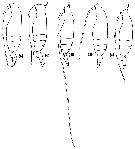 issued from : H.B. Owre & M. Foyo in Fauna Caribaea, 1967, 1, Crustacea, 1: Copepoda. [p.44, Figs.243-247]. Habitus comparison between species in the Florida Current. Female (in lateral view): 243, Gaetanus kruppii; 244, G. latifrons; 245, G. miles; 246, G. minor; 247, G. pileatus. | | | | | (15) Gaidiopsis A. Scott, 1909 ( Aetideinae ) | |
| | Ref.: | A. Scott, 1909 (p.52); Sewell, 1929 (p.101); Tanaka, 1957 b (p.169); Brodsky, 1950 (1967) (p.143); Bradford & Jillett, 1980 (p.55, 57, Rem.); Razouls, 1982 (p.197); 1993 (p.309); Markhaseva, 1996 (p.8, Rem.); Mauchline, 1998 (p.89: F) | | Rem.: | 1 sp. | | | | Gaidius Giesbrecht, 1895 ( Aetideinae ) | |
| | Syn.: | Chiridius (part) Sars; Mesogaidius (part.) Wolfenden, 1911 (p.223); Pseudogaetanus Brodsky, 1950 (1967) (p.143, 144, 169) | | Ref.: | Gaidius Giesbrecht, 1895 c (p.249); Giesbrecht & Schmeil, 1898 (p.32); Sars, 1903 (p.161); Esterly, 1905 (p.145); van Breemen, 1908 a (p.35); A. Scott, 1909 (p.51); Wolfenden, 1911 (p.222); With, 1915 (p.72 & suiv.); Sars, 1925 (p.46, 57); Sewell, 1929 (p.100); Wilson, 1932 a (p.52); Rose, 1933 a (p.96, clé spp.); Davis, 1949 (p.26); Brodsky, 1950 (1967) (p.158, clé spp.); Vervoort, 1952 (n°41, p.2); 1952 d (n°45, p.3); Tanaka, 1957 a (p.60); Park, 1975 a (Rev., p.9,10); Park, 1978 (p.127); Bradford & Jillett, 1980 (Def., p.57); Razouls, 1982 (p.178); Gardner & Szabo, 1982 (p.217); Mauchline, 1988 (p.729); Razouls, 1993 (p.309); Bradford-Grieve, 2004 (p.287) | | Rem.: | type: Gaidius pungens Giesbrecht,1895. Markhaseva (1996, p.176) considère ce genre comme synonyme junior de Gaetanus. | | | | (16) Jaschnovia Markhaseva, 1980 | |
| | Syn.: | Derjuginia Jaschnov, 1947; Brodsky, 1950 (1967) (p.157); Bradford & Jillett, 1980 (Def.,p.29) | | Ref.: | Markhaseva, 1980 a (p.63); Razouls, 1982 (p.177); 1993 (p.309); Markhaseva, 1993 (p.54 & suiv.); 1996 (p.225, Rev.); Mauchline, 1998 (p.78); Boxshall & Halsey, 2004 (p.58: F; 60: M) | | Rem.: | 2 spp. | | Remarques sur les dimensions et le sex-ratio: | | The mean female size is 2.275 mm. (n = 4, SD = 0.301), and the mean male size is 2.120 mm. (n = 2, SD = 0.). The size ratio male: female is 0.932. | | | | (17) Lutamator Bradford, 1969 ( Aetideinae ) | |
| | Ref.: | Bradford, 1969 b (p.491); Bradford & Jillett, 1980 (Def.,p.61); Razouls, 1982 (p.229); Alvarez, 1984 (Rev., p.99); Razouls, 1993 (p.309); Markhaseva, 1993 (p.54 & suiv.); 1996 (p.226, spp. Key, Rem.); Mauchline, 1998 (p.89: F); Bradford-Grieve, 2004 (p.287); Boxshall & Halsey, 2004 (p.56, 58); Ohtsuka & al., 2005 (p.230, Rem.) | | Rem.: | type: Lutamator hurleyi Bradford,1969. 3 spp.: | | Remarques sur les dimensions et le sex-ratio: | | The mean female size is 4.470 mm. (n = 5, SD = 0.914), and the mean male size is 3.380 mm (n = 2, SD = 0.014). The size ratio male: female is 0.974. |  issued from : E.L. Markhaseva & K. Schulz in Mitt. hamb. zool. Mus. Inst., 2008, 105. [p.33, Table 1]. Etat des charactères sélectionnés chez Lutamator et Prolutamator femelles. |
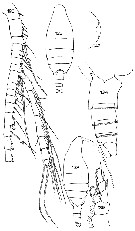 Issued from : J. Bradford in N. Z. J. Mar. Freshw. Res., 1969, 3 (4). [p.492, Figs. 128, 134, 135, 138, 139, 142]. Lutamator hurleyi.
Female: 128, A1; 134, urosome (lateral view); 135, habitus (dorsal view); 138, same (lateral view); 139, P1; 142, forehead (ventral view). | | | | | (18) Mesocomantenna Alvarez, 1986 | |
| | Ref.: | Alvarez, 1986 (p.865, 876: Rem.); Markhaseva, 1993 (p.54 & suiv.); 1996 (p.231, Rem.); Mauchline, 1998 (p.88: F); Markhaseva & Schnack-Schiel, 2003 (p.118, Rem.); Bradford-Grieve, 2004 (p.287); Boxshall & Halsey, 2004 (p.58) | | Rem.: | 1 sp.: | | | | Mesogaidius Wolfenden, 1911 | |
| | Ref.: | Wolfenden, 1911 (p.223); With, 1915 (p.73, 74, Rem.); Park, 1975 a (p.12: syn. de Gaetanus); Bradford & Jillett, 1980 (p.57: syn. de Gaidius); Razouls, 1982 (p.184); 1993 (p.309); Markhaseva, 1996 (p.176: syn. de Gaetanus) | | Rem.: | Cf. Gaetanus | | | | Mesundeuchaeta Wolfenden, 1911 | |
| | Ref.: | Wolfenden, 1911 (p.244); Bradford & Jillett, 1980 (p.80); Markhaseva, 1996 (p.301) | | Rem.: | Cf. Undeuchaeta | | | | (19) Paivella Vervoort, 1965 ( Aetideinae ) | |
| | Ref.: | Vervoort, 1965 (p.199, Rem.); Wheeler, 1970 (p.10, Rem.); Bradford, 1971 (p.31); Bradford & Jillett, 1980 (Def., p.63); Razouls,1982 (p.228); 1993 (p.309); Markhaseva, 1993 (p.54 & suiv.); 1996 (p.233, spp. key, Rem.); Mauchline, 1998 (p.92: F; p.93: M); Bradford-Grieve & al., 1999 (p.918, 922: clé spp.F); Boxshall & Halsey, 2004 (p.57: F; 60: M) | | Rem.: | type: Paivella inaciae Vervoort,1965. 2 spp.: | | Remarques sur les dimensions et le sex-ratio: | | The mean female size is 1.360 mm (n = 4; SD = 0.0860). The size ratio M:F = 0.804 (following only 1 species) | | | | (20) Parabradyidius Schulz & Markhaseva, 2000 | |
| | Ref.: | Schulz & Markhaseva, 2000 (p.78); Bradford-Grieve, 2004 (p.287); Boxshall & Halsey, 2004 (p.58: F; 60: M); Renz & Markhaseva, 2015 (p.96, Table 4, fig.3, biogeography) | | Rem.: | type: Parabradyidius angelikae Schulz & Markhaseva, 2000. Total: 2 spp. (dont 1 juvénile) | | Remarques sur les dimensions et le sex-ratio: | | For one specie only: The mean female size is 5.435 mm, and the mean male size 4.975 mm. The size ratio (male : female) is 0.915. | | | | (21) Paracomantenna Campaner, 1978 ( Aetideinae ) | |
| | Syn.: | Bryaxis (part.) | | Ref.: | Campaner, 1978 (p.871); Bradford & Jillett, 1980 (Def., p.63); Alvarez, 1986 (p.858, 876: Rem.); Razouls, 1993 (p.309); Markhaseva, 1993 (p.54 & suiv.); 1996 (p.236, spp. Key, Rem.); Mauchline, 1998 (p.88: F); Bradford-Grieve & al., 1999 (p.919, 922: spp. Key); Markhaseva & Schnack-Schiel, 2003 (p.118, Rem.); Bradford-Grieve, 2004 (p.287); Boxshall & Halsey, 2004 (p.58); Ohtsuka & al., 2005 (p.240, Rem.); Renz & Markhaseva, 2015 (p.96, Table 4, fig.3, sex ratio, biogeography); Markhaseva & Renz, 2019 (p.223: Rem) | | Rem.: | type: Bryaxis minor Farran,1905. Total: 6 spp.: | | Remarques sur les dimensions et le sex-ratio: | | The mean female size is 1.994 mm (n = 9; SD = 0.4683). Only 1 species with the male has been observed (mean = 1.225 mm; n = 2; SD = 0.353) | | | | (22) Prolutamator Markhaseva & Schulz, 2008 | |
| | Ref.: | Markhaseva & Schulz, 2008 (p.32); Renz & Markhaseva, 2015 (p.96, Table 4, fig.3, biogeography) | | Rem.: | Type: Prolutamator hadalis. Total: 3 species.
Abyssale. | | Remarques sur les dimensions et le sex-ratio: | | The mean female size is 2.550 mm (n = 4; SD = 0.3028). No male observed. |  issued from : E.L. Markhaseva & K. Schulz in Mitt. hamb. zool. Mus. Inst., 2008, 105. [p.33, Table 1]. Etat des caractères sélectionnés chez Lutamator et Prolutamator femelles. | | | | | Pseudaetideus Wolfenden, 1904 ( Aetideinae ) | | Ref.: | Wolfenden, 1904 (p.115); van Breemen, 1908 a (p.32); Brodsky, 1950 (1967) (p.156); Vervoort, 1952 c (n_44, p.3); Matthews, 1964 (p.6); Park, 1975 b (p.272, 273, Rem.); Bradford & Jillett, 1980 (p.19, Rem.); Razouls, 1982 (p.176); 1993 (p.309); Markhaseva, 1996 (p.26) | | Rem.: | type: Euchaeta armata (Boeck,1872). Pour Vervoort (1952) cette espèce est proche de Chiridius obtusifrons . Cf. Aetideopsis | | | | (23) Pseudeuchaeta Sars, 1905 ( Aetideinae ) | |
| | Syn.: | ? Bradyetes Farran, 1905 (p.31);
Autanepsius Wolfenden, 1906 (p.39); 1911 (p.350); | | Ref.: | Sars, 1905 b (p.18); With, 1915 (p.73); Sars, 1925 (p.102); Rose, 1933 a (p.124); Sewell, 1947 (p.104, 105, Rem.); Vervoort, 1952 (n°41, p.2); 1952 h (n°49, p.3); 1957 (p.70); Bradford, 1969 b (Def., p.486); Park, 1978 (p.187); Bradford & Jillett, 1980 (Def. , p.21,63); Razouls, 1982 (p.230); Vaupel Klein, 1984 a (p.57); Markhaseva, 1986 b (p.1896, clé spp.); Mauchline, 1988 (p.729); Razouls, 1993 (p.309); Markhaseva, 1993 (p.54 & suiv.); 1996 (p.240, clé spp., Rem.); Chihara & Murano, 1997 (p.688); Mauchline, 1998 (p.78); Markhaseva & Schnack-Schiel, 2003 (p.118, Rem.); Bradford-Grieve, 2004 (p.287); Boxshall & Halsey, 2004 (p.58: F; 60: M); Vives & Shmeleva, 2007 (p.593); Renz & Markhaseva, 2015 (p.96, Table 4, Fig.3, sex ratio, biogeography) | | Rem.: | type: Autanepsius minor Wolfenden, 1906. 8 spp. | | Remarques sur les dimensions et le sex-ratio: | | The mean female size is 7.903 mm (n = 9; SD = 1.9168). The size ratio (Male:Female) is 1.03 but established for a single species. and not representative. The sex ratio is in disfavor of the males, like one observes in the forms living at great depths. | 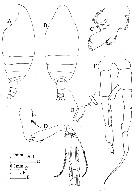 Issued from : J.M. Bradford & J.B. Jillett in N. Z. Oceanogr. Inst. Memoir 86, 1980. [p.65, Fig.43]. Pseudeuchaeta brevicauda. Female (from 41°45'S, 175°01'E): A-B, lateral and dorsal, respectively); C, Mx1; D, Mxp; E, distal part of basipod 1 of Mxp. Male (from Izu region): F, P5. |
 Issued from : E.L. Markhaseva, I. Mohrbeck & J. Renz in Mar. Biodiv., 2017, 47. [p.296, Fig.8] Distributional ranges of the pelagic Pseudeuchaeta major and benthopelagic species of the genus. (for refetences of literature sources compiled, see Markhaseva, 1996 and Mathhaseva & Schulz, 2008). | | | | | (24) Pseudochirella Sars, 1920 ( Euchirellinae ) | |
| | Ref.: | Sars, 1920 c (p.5); Sars, 1925 (p.83); Sewell, 1929 (p.127); Rose, 1933 a (p.109); Sewell, 1947 (p.96, Rem.); Davis, 1949 (p.32); Brodsky, 1950 (1967) (p.185, Key spp.); Vervoort, 1952 (n°41, p.2); 1952 g (n°48, p.3); 1957 (p.63, 64, Rem.); Tanaka,1957 b (p.192); Tanaka & Omori, 1969 a (p.155); Park, 1978 (p.158); Bradford & Jillett, 1980 (Def., p.66, Rem.); Razouls, 1982 (p.220); Gardner & Szabo, 1982 (p.251); Vaupel Klein, 1984 a (p.52, Rem.); Mauchline, 1988 (p.730); Markhaseva, 1989 (p.37, spp.: Key F & M); Razouls, 1993 (p.309); Markhaseva, 1993 (p.54 & suiv.); Vaupel Klein, 1996 (p.446, Rem., Def., p.450); Markhaseva, 1996 (p.253, clé spp., Rem.); Chihara & Murano, 1997 (p.688); Mauchline, 1998 (p.87, 92: F; p.90, 93: M); Bradford-Grieve & al., 1999 (p.919, 923: Key spp.); Boxshall & Halsey, 2004 (p.58, 61); Vives & Shmeleva, 2007 (p.595, spp. Key) | | Rem.: | type non désigné, Pseudochirella obesa proposé par Vaupel Klein.
Yotal: 30 spp. + 1 indet.: | | Remarques sur les dimensions et le sex-ratio: | | The mean female size is 6.175 mm (n = 50; SD = 1.3015) and that of males 5.564 mm (n = 20; SD = 0.8959). The size ratio Male:Female is 0.901. The sex ratio (F:M) is 4.33. | 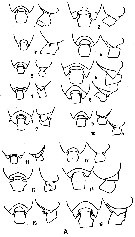 Issued from : E.L. Markhaseva in Issled. Fauny Morei, 1989, 41 (49). [p.52, Fig.7 A]. Segment genital female (dorsal and lateral). Key identification for females of all valid (according to author's opinion) Pseudochirella species. 1 - P. dubia; 2 - P. hirsuta; 3 - P. spinosa; 4 - P. obtusa; 5 - P. lobata; 6 - P. formosa; 7 - P. spectabilis; 8, P. batillipa; 9 - P. divaricata; 10 - P. vervoorti; 11 - P. limata; 12, P. obesa; 13 - P. tanakai; 14 - P. scopularis; 15 - P. dentata; 16 - P. palliata |
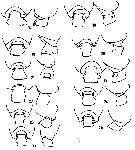 Issued from : E.L. Markhaseva in Issled. Fauny Morei, 1989, 41 (49). [p.53, Fig.7 B]. Segment genital female (dorsal and lateral). Key identification for females of all valid (according to author's opinion) Pseudochirella species (continued). 17 - P. gibbera; 18 - P. elongata; 19 - P. bilobata; 20 - P. accepta; 21 - P. mawsoni; 22 - P. pustulifera; 23 - P. notacantha; 24 - P. pacifica; 25 - P. bowmani; 26 - P. mariana; 27 - P. fallax. |
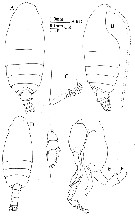 Issued from : J.M. Bradford & J.B. Jillett in N. Z. Oceanogr. Inst. Memoir 86, 1980. [p.72, Fig.48]. Pseudochirella obesa. Female (from 34°56'S, 175°23'E): A-B, habitus (dorsal and lateral, respectively); C, Coxa of P4. Male (from Cape Verde Islands): D, habitus (dorsal); E, exopod of P1; F, P5. | | | | | Pseudogaetanus Brodsky, 1950 ( Aetideinae ) | |
| | Ref.: | Brodsky, 1950 (1967) (p.169); Grice & Hulsemann, 1967 (p.24, Rem.); Park, 1975 a (p.12); 1978 (p.127); Bradford & Jillett, 1980 (p.57); Razouls, 1982 (p.195); 1993 (p.309); Markhaseva, 1996 (p.176) | | Rem.: | type: Pseudogaetanus robustus (Sars,1905). Cf. Gaetanus | | | | (25) Pseudotharybis T. Scott, 1909 ( Aetideinae ) | |
| | Ref.: | T. Scott, 1909 (p.126); Wilson, 1932 a (p.551, 553); Bradford, 1976 a (p.9, Rem.); Bradford & Jillett, 1980 (Def., p.71); Razouls, 1982 (p.198); Bradford & al., 1983 (p.123); Razouls, 1993 (p.309); Mauchline, 1998 (p.84: F); Markhaseva, 1996 (p.8, Rem.); Bradford-Grieve, 2004 (p.287); Boxshall & Halsey, 2004 (p.58: F; 60: M); Renz & Markhaseva, 2015 (p.96, Table 4, fig.3, sex ratio, biogeography) | | Rem.: | Genre exclu des Tharybidae par Bradford (1976 a) et considéré comme intermédiaire entre les Aetideidae et les Tharybidae par Markhaseva (1996). Type: Pseudotharybis zetlandicus. Total: 7 spp. | | Remarques sur les dimensions et le sex-ratio: | | The mean female size is 4.213 mm (n = 6; SD = 0.9517), and 3.972 mm for the males (n = 5; SD = 0.4358). The size ratio Male:Female 0.943. | 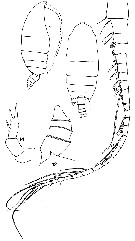 Issued from : J.M. Bradford inN Z J. Mar. Freshw. Res., 1969, 3 (4) [p.477, fig.s, 8, 11, 12, 14, 17). As Bradyidius robustus (= Pseuditharybis robustusFemale: 8, A1; 11, habitus (lateral view); 12, urosome (lateral view); 14, P5; 17, habitus (dorsal view). |
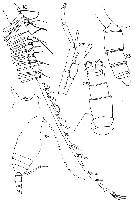 Issued from : J.M. Bradford inN Z J. Mar. Freshw. Res., 1969, 3 (4). [p.478, figs. 18, 25, 26, 27, 28, 30]. As Bradyidius robustus (= Pseuditharybis robustusMale: 18, A1; 25-26, urosome (dorsal and lateral view, respectively); 27, P5; 28, habitus (lateral view); 30, rostrum. | | | | | (26) Pterochirella Schulz, 1990 | |
| | Ref.: | Schulz, 1990 (p.182); Razouls, 1993 (p.309); Markhaseva, 1996 (p.295, Rem.); Mauchline, 1998 (p.66); Bradford-Grieve, 2004 (p.287); Boxshall & Halsey, 2004 (p.60: M) | | Rem.: | Type: Pterochirella tuerkayi Schulz, 1990. Total: 1 sp.
La structure tégumentaire céphalique dorsale est tout à fait originale et apparaît unique parmi les Calanoides par la transformation du tégument céphalique dorsal..
Ce genre présente des affinités avec Bradyetes et Pseudeuchaeta. Total: 1 sp.: | 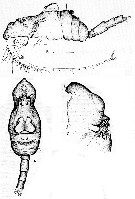 Issued from : K. Schulz in Mitt. hamb. zool. Mus. Inst., 1990, 87. [p.183, Fig.1; p.184, Fig.2]. Pterochirella tuerkayi. Male (from western Gulf of Aden): A, habitus (dorsal view); B, habitus (lateral view; scale bar = 0.5 mm); C, cephalosome (lateral). | | | | | (27) Senecella Juday, 1923 | |
| | Ref.: | Juday, 1925 (p.1); Gurney, 1931 a (p.19); Dussart, 1983 (p.9); Vyshvartzeva, 1994 (p.113); Markhaseva, 1996 (p.297, clé spp., Rem.); Boxshall & Halsey, 2004 (p.58: F; 60: M) | | Rem.: | dulçaquicole (relicte) et saumâtre. Total: 2 spp.: | | Remarques sur les dimensions et le sex-ratio: | | The mean female size is 2.957 mm (n = 4; SD =: 0.2706), and for the males 2,670 mm n = 4; SD = 0.203). The size ratio (Male:Female) is 0.903. The sex ratio is 1. | | | | Snelliaetideus Vervoort, 1949 ( Aetideinae ) | |
| | Ref.: | Vervoort, 1949 (p.3); Bradford, 1971 (p.32); Roe, 1975 (p.305); Park, 1978 (p.108); Bradford & Jillett, 1980 (p.14); Razouls, 1982 (p.228); 1993 (p.309); Markhaseva, 1996 (p.11, Rem.) | | Rem.: | type: S. arcuatus Vervoort,1949. Cf. Aetideus | | | | (28) Sursamucro Bradford, 1969 ( Aetideinae ) | |
| | Ref.: | Bradford, 1969 b (p.488, 491); Bradford & Jillett, 1980 (p.77, Def.); Razouls, 1982 (p.229); 1993 (p.309); Markhaseva, 1993 (p.54 & suiv.); 1996 (p.299, Rem.); Mauchline, 1998 (p.80, 89: F); Bradford-Grieve, 2004 (p.287); Boxshall & Halsey, 2004 (p.58) | | Rem.: | type: Sursamucro spinatus Bradford,1969. Total: 1 sp. | 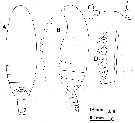 Issued from : N. Z. Oceanogr. Inst. Memoir 86, 1980. [p.79, Fig.55]. Sursamucro spinatus. Female (from NE coast of N New Zealand; depths 1210-1697 m): A-B, habitus (dorsal and lateral, respectively; C, P5; D, part of terminal spine of exopod of P3. | | | | | (29) Undeuchaeta Giesbrecht, 1888 ( Euchirellinae ) | |
| | Syn.: | Mesundeuchaeta Wolfenden, 1911 (p.244);
Euchaete : With, 1915 (p.72, 74) | | Ref.: | Giesbrecht, 1892 (p.54, 227); Giesbrecht & Schmeil, 1898 (p.33); Sars, 1900 (p.58); Esterly, 1905 (p.147); van Breemen, 1908 a (p.42, spp. Key); A. Scott, 1909 (p.60) ; Wolfenden, 1911 (p.243); Sars, 1925 (p.79); Sewell, 1929 (p.123); Wilson, 1932 a (p.60); Rose, 1933 a (p.107); Mori, 1937 (1964) (p.40); Sewell, 1947 (p.102, Rem.); Brodsky, 1950 (1967) (p.181, spp. Key); Vervoort, 1952 (n°41, p.2); 1952 h (n°49, p.3); Tanaka, 1957 b (p.199); Park, 1978 (p.182, Rem: synonymies); Bradford & Jillett, 1980 (Def.,p.80); Razouls,1982 (p.216); Gardner & Szabo, 1982 (p.247); Vaupel Klein, 1984 a (p.52, Rem.); Mauchline, 1988 (p.730); Razouls, 1993 (p.309); Markhaseva,1993 (p.54 & suiv.); 1996 (p.301, spp. Key, Rem.); Chihara & Murano, 1997 (p.689, spp. Key); Mauchline, 1998 (p.88: F; p.93: M); Bradford-Grieve & al., 1999 (p.919, 923: spp. Key); Boxshall & Halsey, 2004 (p.58: F; 61: M); Vives & Shmeleva, 2007 (p.603, spp. Key) | | Rem.: | type: Undeuchaeta major Giesbrecht,1888. Vaupel Klein (1984 a, p.55) is convinced that Undeuchaeta incisa is more suitable substitute as type-species. Total: 5 spp. (dont 1 douteuse) + 1 sp. | | Remarques sur les dimensions et le sex-ratio: | | The mean females size is 4.780 mm (n = 9; SD = 1.3009), and the mean male size is 4.025 mm (n = 8; SD = 1.030). The size ratio (Male:Female) is 0.842. The sex-ratio is 1. |  Issued from : G.O. Sars in Résult. Camp. scient. Prince Albert I, 1924, LXIX [p.12, PL XXIII, figs. 7-12]. Undeuchaeta major Giesbrecht. Female: 7, habitus adult (dorsal view); 8, same (lateral view); 9, forehead (lateral view); 10, genital segment, posterolateral corner of last thoracic segment and 2nd urosomal segment (left side). Male: 11, habitus adult (lateral view); 12, P5. |
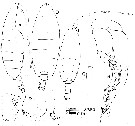 Issued from : J.M. Bradford & J.B. Jillett in N. Z. Oceanogr. Inst. Memoir 86, 1980. [82, Fig.57]. Undeuchaeta major. Female (from 34°32'S, 157°31.5'E): A-B, habitus (lateral and dorsal, respectively); C, right side of genital segment; D, dorsal view of genital segment; E, inner edge of coxa of P4. Male: F, habitus (dorsal view); G, lateral view of anterior head; H, P5. | | | | | Undinopsis Sars, 1902 ( Aetideinae ) | | Ref.: | Schneider,1884 (nom. nudum ); Sars, 1902 (1903) (p.31); With, 1915 (p.73); Sewell, 1929 (p.99); Rose, 1933 a (p.91); Brodsky, 1950 (1967) (p.143, 150); Tanaka, 1957 a (p.44); Matthews, 1964 (p.18); Bradford & Jillett, 1980 (p.21); Razouls, 1982 (p.167); Alvarez, 1984 (p.96); Razouls, 1993 (p.309); Markhaseva, 1996 (p.68) | | Rem.: | type: Undinopsis bradyi Sars,1902 Cf. Bradyidius | | | | (30) Valdiviella Steuer, 1904 (? Aetideidae, Aetideinae ) | |
| | Ref.: | Steuer, 1904 (p.593, 596); A. Scott, 1909 (p.77); Wolfenden, 1911 (p.12, 247); With, 1915 (p.154); Sars, 1925 (p.98); Sewell, 1929 (p.133, Rem.); Rose, 1933 a (p.124); Sewell, 1947 (p.109, Rem.); Brodsky, 1950 (1967) (p.196, 223); Tanaka, 1957 b (p.204); Vervoort, 1957 (p.86,87, Rem.) (p.204); Owre & Foyo, 1967 (p.50); Heptner, 1971 (p.112, Rem.); Razouls, 1972 (Annexe: p.39: Rem.); Zvereva, 1975 (p.1893, Rem.); Park, 1978 (p.191); Bradford & Jillett, 1980 (Def., p.83); Razouls, 1982 (p.231); Mauchline, 1988 (p.729); Razouls, 1993 (p.310); Markhaseva, 1996 (p.8: Rem.); Chihara & Murano, 1997 (p.690); Mauchline, 1998 (p.93: F, M); Bradford-Grieve & al., 1999 (p.924, 927: clé spp.; dans la famille des Euchaetidae ); Boxshall & Halsey, 2004 (p.57: F; 60: M); Vives & Shmeleva, 2007 (p.606, spp. Key) | | Rem.: | Type: Valdiviella oligarthra Steuer,1904. Total: 7 spp.
L'appartenance de ce genre à cette famille est discutée par Heptner (1971) et Zvereva (1975). | | Remarques sur les dimensions et le sex-ratio: | | The mean female size is 7.278 mm (n = 11; SD = 2.4288), and the mean male size is 6.822 mm (n = 8; SD = 1.9816). The size ratio (Male:Female) is 0,937. Le sex-ratio (F:M) is 1,2. | 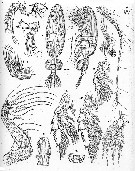 Issued from : G.O. Sars in Résuult. Camp. scient. Prince Albert I, 1924, LXIX. [p.14, PL XXVII]. Valdiviella insignis Farran. Female: 1, habitus adult ovigerous (dorsal view); 2, same (lateral view); 3, forehead (lateral view); 4, rostrum; 5, A1; 6, A2; 7, Md; 8, Mx1 (Maxille); 9, Mx2 (maxillipède antérieur); 10, Mxp (maxillipède postérieur); 11, P1; 12, P2; 13, P4; 14, genital segment and 2nd urosomal segment left side); 15, genital area (ventral view); 16, Anal segment and left caudal ramus. |
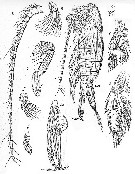 Issued from : G.O. Sars in Résuult. Camp. scient. Prince Albert I, 1924, LXIX. [p.14, PL XXVIII]. Valdiviella insignis. Male: 1, habitus (lateral view); 2, rostrum; 3, A1; 4, mandibular palp; 5, Mx1; 6, Mx2; 7, Mxp; 8, P1; 9, P4; 10, P5. |
 Issued from : J.M. Bradford & J.B. Jillett in N. Z. Oceanogr. Inst. Memoir 86, 1980. [p.85, Fig.59]. valdiviella insignis. Female (from 31°19'S, 165°19'E): A^B, habitus (dorsal and lateral, respectively); C, rostrum; D, P1; E, P4. Male (from 41°53'S, 175°14'E): F-G, habitus (lateral and dorsal, respectively); H, P5. | | | | | Wilsonidius Tanaka, 1969 ( Aetideinae ) | |
| | Ref.: | Tanaka, 1969 (p.266); Bradford & Jillett, 1980 (p.92); Razouls, 1982 (p.230); 1993 (p.310); Markhaseva, 1996 (p.8, 129, Rem.); Mauchline, 1998 (p.92: F) | | Rem.: | type:Wilsonidius alaskaensis Tanaka,1969. Cf.: Chirundina | | | | | | | | | | | | | | | | |
|
|
 Toute utilisation de ce site pour une publication sera mentionnée avec la référence suivante : Toute utilisation de ce site pour une publication sera mentionnée avec la référence suivante :
Razouls C., Desreumaux N., Kouwenberg J. et de Bovée F., 2005-2025. - Biodiversité des Copépodes planctoniques marins (morphologie, répartition géographique et données biologiques). Sorbonne Université, CNRS. Disponible sur http://copepodes.obs-banyuls.fr [Accédé le 25 décembre 2025] © copyright 2005-2025 Sorbonne Université, CNRS
|
|
 |
 |














































